Despite regular tips and pleas from the United States Forest Service and other agencies, wildfires still happen and wildfire planning is still needed.
Whether ignited by a careless camper or a lightning storm, it’s 100 percent certain that forests are going to burn, highways are going to be closed, and people are going to suffer the effects of the smoke, heat, and flames wildfires produce.
It happens, without fail, every year.
It’s impossible to predict where the next wildfire will start or which cities will be affected. We don’t know how many acres will burn or how many homes and businesses will be destroyed. All we know for sure is that wildfires will continue to occur.
What can you do?
That’s what we’ll discuss in this article. We’ll describe the basics of a program FACS wildfire experts developed to help you prepare in advance to move quickly and decisively when the sky fills with smoke and wildfire threatens to disrupt your business.
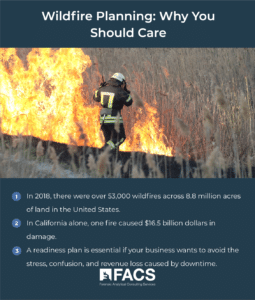
- What can we do to strengthen the protection level for our property and people?
- What public-facing liabilities do we need to protect against?
- Should we evacuate or shelter in place? How do we know when to act?
- How do we maintain good air quality inside our facilities when the outside air is heavy with smoke?
- Who will be in charge of updating our wildfire plan and making sure it’s followed?
- Are we liable for smoke-related illness of our workers?
The lack of a properly prepared and executed plan can mean losses to property, losses to revenue, adverse impact on employees, and even lead to lawsuits against the business for failing to plan and react appropriately.
But here’s some good news:
FACS wildfire experts created a program to help business owners and managers develop a wildfire preparedness, response, and recovery plan specific to their particular situation and needs.
Advance preparation can help protect lives and conserve resources when a wildfire threatens your facilities and forces staff to make critical decisions in a hurry.
In this article, we’ll look deeper into the problem, then we’ll outline the FACS solution.
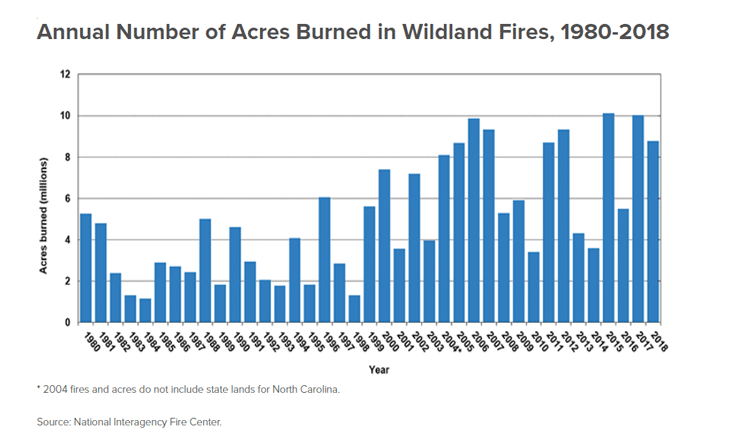
Wildfire Planning for Businesses: The Need is Tremendous
The 2018 Camp Fire in California destroyed over 18,000 buildings. Total costs for that fire are about $422 billion.
But the Camp Fire wasn’t the only wildfire in the U.S. There were 53,082 others in 2018 alone (see the graph above). Altogether, those fires ravaged 8.8 million acres and demolished the dreams of hundreds of thousands of people.
Wildfires happen every year. Nothing we do or say can stop them from igniting, and there is little we can do about where they start. Weather patterns can turn normally low-risk areas into tinderboxes.
We can’t stop wildfires from occurring, but we can prepare for them — yet many people don’t take time to plan in advance. Whether they think “It won’t happen to me” or “I’m too busy” or “There’s not much I can do anyway” … wildfire planning too often gets ignored — until it’s too late.
A properly-prepared wildfire readiness plan can help relieve the stress and confusion that’s sure to arise when news broadcasts announce the newest fire and the smell of smoke in the air begins to stir up worried conversations among employees and customers.
Once fire ash begins to collect on cars and those ominous dark, billowing clouds appear on the horizon, wildfire planning begins to look far more desirable. By then, though, it’s usually too late to do much more than try frantically to get ready for the impact. Every business needs a strategic plan for how they will prepare for, respond to, and recover from wildfire emergencies.
Those three needs — prepare, respond, and recover — are the building blocks of the FACS method for helping businesses develop and implement the crucial components of wildfire planning at their locations.
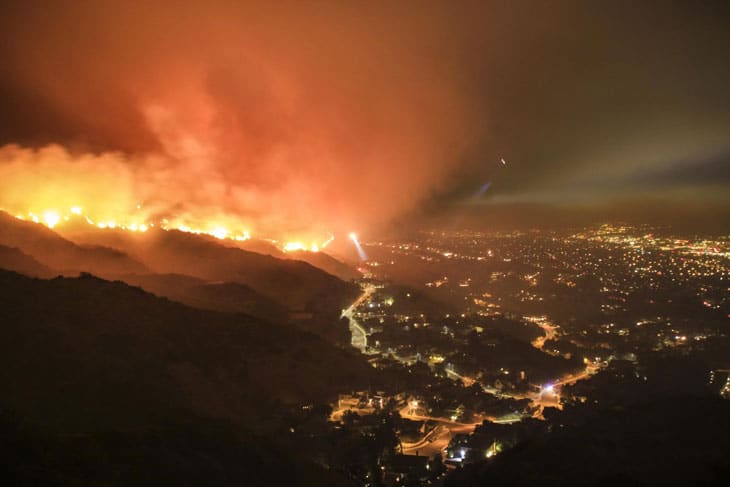
Wildfire Planning: The FACS Method
We can’t outline the entire wildfire planning method here. Much will depend on where your business is located and what you most want to accomplish. Some companies are concerned about establishing a protective barrier, others want to be sure they can stay open for business as long as possible, some are primarily concerned about the welfare of their employees and customers … and all of that can and should be addressed in your wildfire preparedness plan.
Here are examples of the components FACS experts suggest:
Know How to Prepare for Wildfire Emergencies
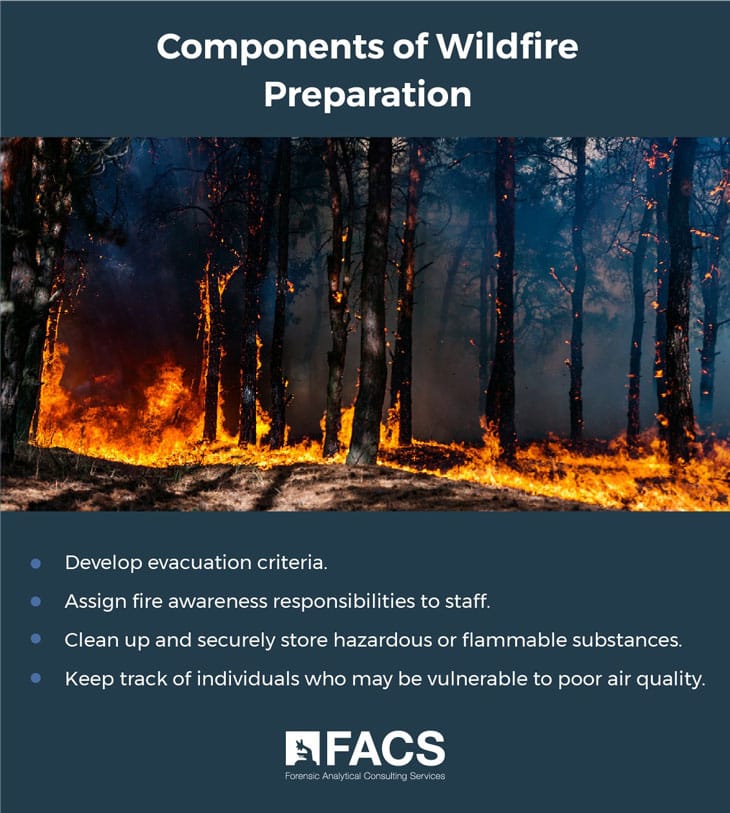
Preparation is the key to success.
Here are examples of areas to cover during preparation:
- Develop criteria for deciding when and how to evacuate. You’ll need a lock-down and security plan for the business, alternate emergency escape routes, and vehicles fully fueled and stocked.
- Decide who will ensure fire awareness is maintained and who will be in charge of moving your wildfire plan to the next response level, should conditions warrant.
- Do all you can to prevent an inadvertent release of chemical hazards. That begins by listing all hazardous chemicals and substances used at your business (including cleaning supplies). They must be stored securely.
Most businesses have employees who are especially susceptible to lowered air quality (asthma sufferers, for instance). Make sure you are able to recognize and respond to those situations. You’ll want to train your team on what to expect when smoke becomes an issue and how to protect themselves to minimize risks of exposure.
Know How to Respond to Wildfire Threats
Your response will depend on how close the wildfire is to your business and the weather patterns in place. It’s important to remember that wind-carried smoke can cause significant lowering of air quality, even at businesses located hundreds of miles from the flames.
Your plan should take into account the various levels of threat. Your response will be much different when the fire erupts nearby and immediate evacuation orders are given than it will be when your concern is primarily about keeping the outside air quality from compromising the air quality inside.
Portable air filtration devices, sticky mats to reduce the spread of particulate matter, and closing down certain entryways to limit the inflow pathway of air are examples of devices and methods you can use to maintain the quality of air inside your business. All of this, of course, requires advance planning and will be specific to your situation.
Once the threat is obvious, it may be difficult to obtain the devices you need to protect your facilities. And once a door is opened by mistake and smoke-filled air rushes in, your current HVAC system may not be able to handle the load adequately.
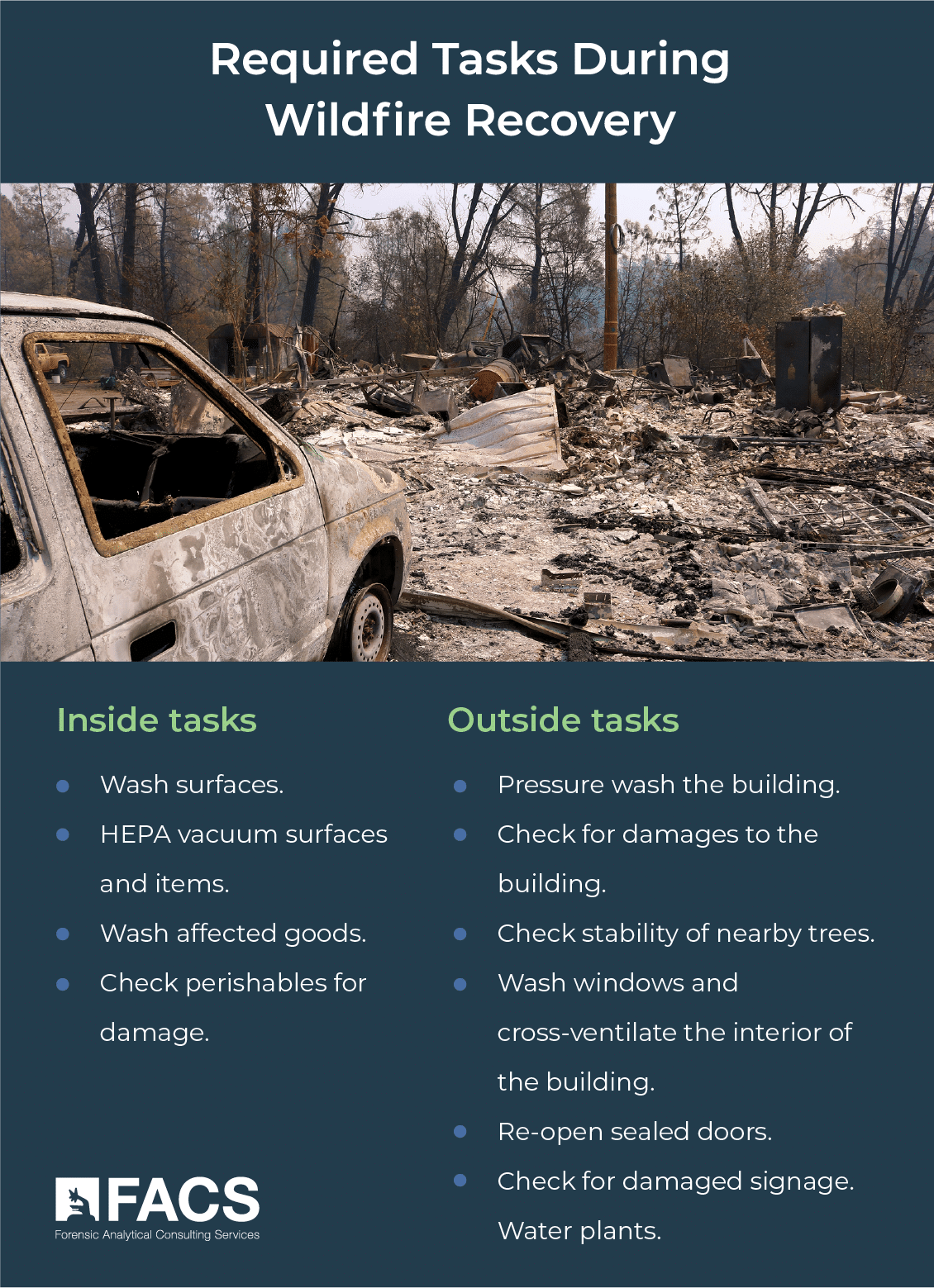
For instance, HVAC systems get stressed when they’re forced to deal with wildfire smoke and particulates. One thing you should always do is inspect your air delivery system and install fresh filters. This may seem fundamental, but FACS specialists often find inadequately functioning HVAC systems when called to investigate air quality issues.
Here is a short list of other actions that are typically necessary during the wildfire restoration phase:
Example of inside tasks:
- Wash walls and ceilings
- HEPA vacuum floors and damp-wipe them
- Clean furniture and fixtures
- Wash affected goods
- Check perishables for damage
Note that cleaning should begin in the center of each level and work towards the entries. Work from ceiling to floor and room to room to avoid cross-contamination.
Examples of outside tasks:
- Pressure wash the building as needed. Check for damages.
- Check the stability of nearby trees and other objects that have been damaged by the fire. Fire-weakened trees can fall suddenly. They pose a severe hazard.
- Wash windows and check seals. Open windows in a pattern that will cross-ventilate the interior.
- Re-open doors that were sealed during the wildfire event.
- Check signage for damage and clean as needed.
- Water lawns, flowers, and shrubbery.
Employees and customers may want immediate access to your facilities, but you should not reopen until your buildings and grounds have been cleaned properly and cleared for entry. Having and following a well-thought-out procedure is necessary to protect public health and can help defend your company against liability issues.
Prepare, Respond, Recover: The Basics of Your Wildfire Protection Plan
There is much more to wildfire planning than we have covered here. If we could suggest a one-size-fits-all template, we’d gladly give it to you … but there isn’t one. A proper wildfire preparedness, response, and recovery plan for your business must be tailored to your particular situation.
That’s why FACS launched this special program to help create a wildfire readiness plan for commercial interests. We want you to keep wildfire worries to a minimum by getting properly prepared. We want your staff to be capable of responding quickly and correctly to any type of wildfire threat that might arise. And we want you to get back on your feet and into full operational capacity as quickly and safely as possible once the danger has passed.
For help compiling a wildfire readiness plan for your business, contact FACS at (888) 711-9998 or use our online contact form here: https://facs.com/contact-us/.
NOTE: The information we’ve provided in this article is meant only to create awareness of the need for wildfire planning. This is by no means an exhaustive treatment of the issue.
###
Images Cited:
National Interagency Fire Center. “Number of Acres Burned in Wildland Fires. Insurance Information Institute, 2019,l https://www.iii.org/fact-statistic/facts-statistics-wildfires.